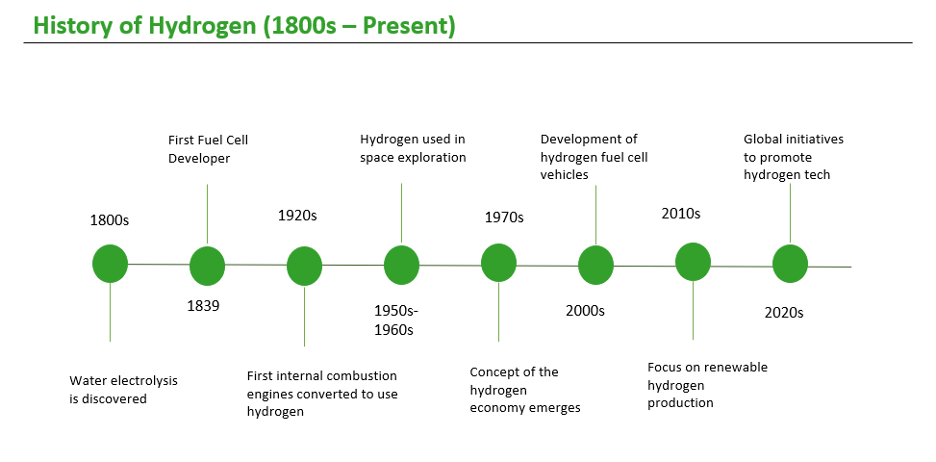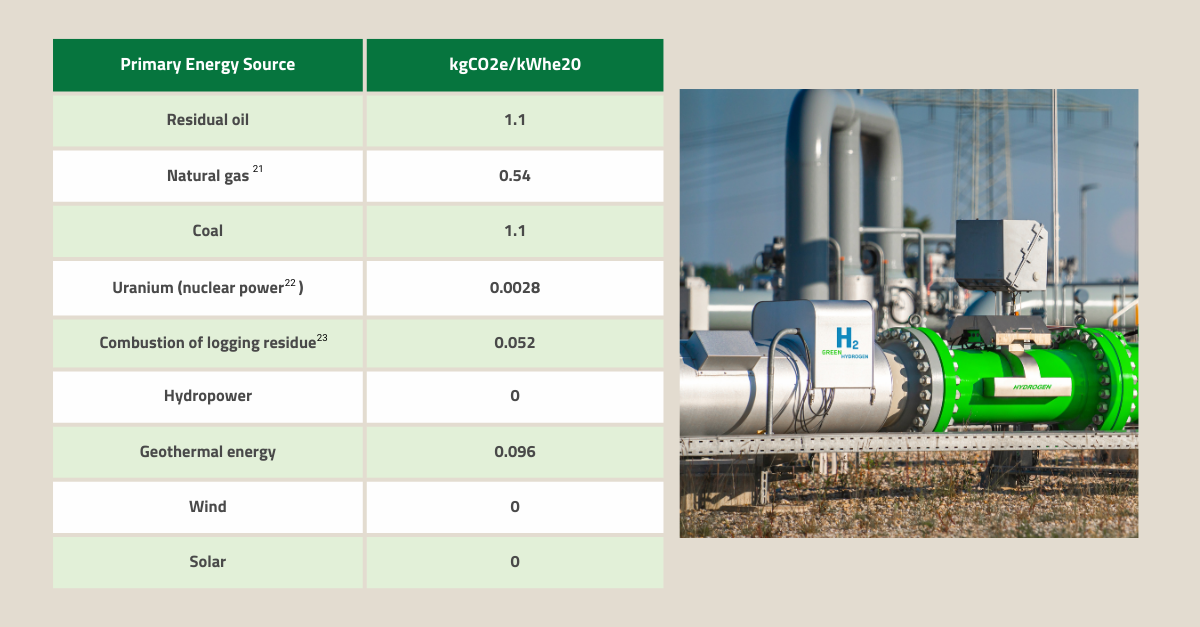Hydrogen (H2) is a crucial energy carrier and feedstock for many industries. The history of the hydrogen molecule dates back hundreds of years; it was first produced through electrolysis in 1789, used in a fuel cell in 1838, and has powered NASA’s space exploration since the 1950s.
Moreover, the technology behind the production of green hydrogen is not new. Alkaline electrolysis has existed since the early 1900s, and proton exchange membrane (PEM) electrolysis, which Novo prefers for our projects, has been available since the 1970s.
Today, over 10 million metric tons of hydrogen are produced annually in the U.S., mostly derived from fossil fuels.
So why the sudden interest in hydrogen? Although electrolysis technology and the use of hydrogen are established, the scale of green hydrogen production and its novel applications are recent developments. Technological improvements, significant federal funding support, and public and private sector decarbonization goals are also driving interest. Increased interest has led to some common misconceptions worth reviewing further.
Misconception 1: Green Hydrogen Contributes to Climate Change.
Green hydrogen is a critical decarbonization technology for hard-to-abate sectors, especially where direct electrification is not feasible. While electrolysis can be an energy-intensive process, the production of green hydrogen is carbon-free when powered by renewable energy. Another benefit is the production of green hydrogen from water electrolysis generates oxygen, which can be captured and used by industrial facilities. By contrast, grey hydrogen produces greenhouse gas (GHG) emissions in its creation. This is primarily due to the steam methane reforming process, which largely uses methane (i.e., natural gas), a potent GHG, as the feedstock.
When used in a fuel cell or burned, hydrogen emits no carbon dioxide (CO2), only releasing water vapor. It is worth noting that nitrogen oxides (NOx) emissions can occur in combustion use cases if the hydrogen is burned in atmospheric oxygen rather than pure oxygen.
However, because hydrogen is the smallest molecule on earth, indirect emissions are possible through leaks during production, transportation, or storage. NovoHydrogen is proactive in addressing these risks by implementing stringent leakage prevention strategies, such as integrating sensors and thorough monitoring systems. Reducing leaks not only preserves the product but also enhances its environmental benefits. According to the Environmental Defense Fund, even with leakage rates between 1-10%, the climate advantages of green hydrogen surpass those of methane-based or “blue” hydrogen.
Misconception 2: All hydrogen is equally “clean”.
Hydrogen can be produced from various sources, such as fossil fuels, biomass, or water. Depending on the process used to create hydrogen, CO2 can be emitted. The carbon intensity is the measure of the amount of CO2 emissions associated with the production of hydrogen and is dependent on the production route.
For instance, most hydrogen on the market today is produced with a process called steam methane reforming which splits methane into hydrogen and CO2. According to the EIA, hydrogen produced in this way from unabated fossil fuels (e.g., grey hydrogen) can have an intensity of up to 27 kg CO2e/kg H2.
Blue hydrogen follows the same process, but the carbon is captured and sequestered. Hydrogen produced from abated fossil fuels can have an intensity of 0.8 – 8 kg CO2e/kg H2, depending on the capture rate and upstream and midstream emissions. By contrast, green hydrogen, produced with water electrolysis by renewable energy has an intensity of 0 kg CO2e/kWhe as shown in Figure 1.
Misconception 3: Hydrogen is unsafe.
Hydrogen has been safely used by industries for over four decades.

Many fire and safety codes, regulations, and environmental standards have been in place for decades to ensure the safe handling, storage, and transport of hydrogen. The Department of Energy also conducts ongoing research to maintain these safety codes as usage potentially increases. In fact, proton exchange membrane (PEM) electrolysis has been around since the 1960s for NASA’s space program, which necessitated an extremely stringent safety protocol foundation.
At NovoHydrogen, we are designing our facilities to the highest engineering and safety standards and to meet all required safety, regulatory and code requirements such as . We are also engaged with the global hydrogen safety community as members of the Center for Hydrogen Safety.
Misconception 4: Green hydrogen production uses too much water.
Water is used to make green hydrogen by splitting water molecules with renewable energy to produce hydrogen and oxygen.
According to Rocky Mountain Institute, the water reacted during electrolysis is less than fossil-fuel-based hydrogen production methods, which require significant upstream water consumption from natural gas drilling, extraction, and processing. By contrast, coal gasification requires 25 – 26L/kgH2, steam methane reforming requires 21 – 27L/kgH2, and blue hydrogen requires 32 – 39 L/kgH2.
The Rocky Mountain Institute also notes the total water demand for producing green hydrogen for a climate-aligned future is modest, increasing the U.S.’s water use by just 0.26%.
To minimize impacts on local water availability, during project planning we prioritize efficient process design and evaluate water sourcing and project siting options to avoid exacerbating water resource constraints. For example, at our California Antelope Valley Hydrogen 1 facility, our water consumption will be less than 10% of the water needed for the previous land use supporting agriculture.
Misconception 5: Green hydrogen is not economically viable.
With technological advancements and economies of scale, the cost of producing green hydrogen is steadily decreasing. The recent passage of the Inflation Reduction Act in 2022 provides a Production Tax Credit (PTC) for green hydrogen, worth up to $3/kg for the lowest carbon production pathways, to incentivize producers and support cost-competitive supply. When factoring in the tax credit, green hydrogen can be on par or cheaper than grey hydrogen.
Beyond federal support, multiple state-level programs are driving green hydrogen adoption such as low carbon fuel standards (LCFS) and industrial decarbonization mandates in states like CA, OR, WA, CO, and NY. It’s also important to note that, grey hydrogen and blue hydrogen prices are subject to the volatility of natural gas prices, whereas green hydrogen is not.
It is important to acknowledge that green hydrogen is not a one-size-fits-all solution. In our discussions, we’ve pointed out that green hydrogen is particularly effective for certain applications, especially where hydrogen is already a staple fuel stock or energy source. However, in many cases, using clean electricity or other decarbonization alternatives directly can be more efficient than converting hydrogen into electricity.
Additionally, it is worth discussing the cost of climate inaction. Multiple studies have been done to determine the cost of inaction, and as an example, a Deloitte study found that inaction on climate change could cost the world’s economy $178 trillion by 2070. Business as usual is leading to costly extreme weather events, food and water scarcity, and an overall lower standard of living globally. Deloitte’s study also found that if we transitioned to net-zero, the global economy could see gains of $43 trillion over the next five decades.
Misconception 6: Green hydrogen infrastructure will affect land in negative ways.
We prioritize project stakeholder relations and the local community’s needs throughout every step of the project development process. We partner with our landowners to ensure that the land is preserved for the long term and is reusable for future generations.
During project development, we conduct environmental field surveys and analyses to record the baseline environmental conditions and potential impact of our projects. We use this data, along with best construction management practices, to minimize impacts to sensitive environmental areas during construction and operation.
All of our projects include a Decommissioning Plan and Bond before construction commences. This ensures that there will always be funding available for the project decommissioning and land restoration at the end of the project lifecycle.

 Figure 1 – Emissions Factors of Electricity Generation from Various Primary Energy Sources in 45VH2-GREET 2023
Figure 1 – Emissions Factors of Electricity Generation from Various Primary Energy Sources in 45VH2-GREET 2023